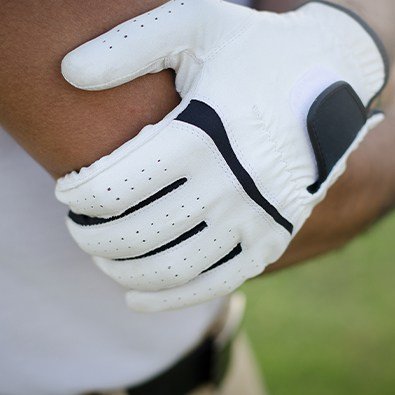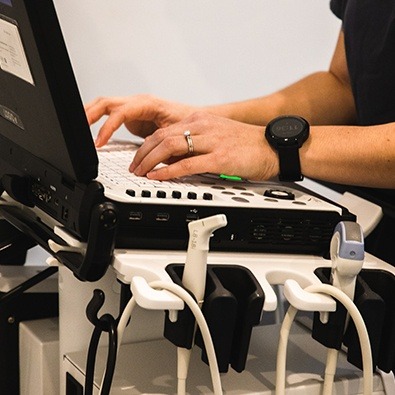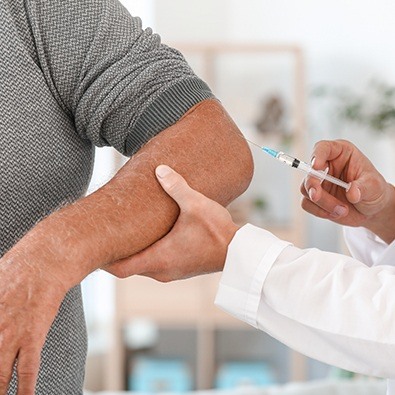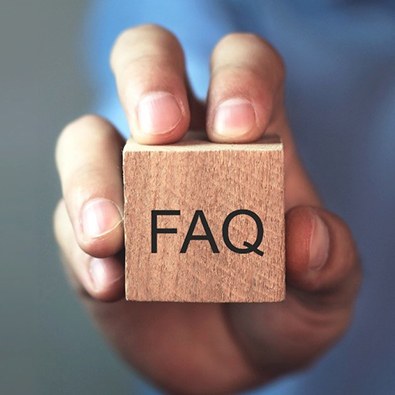
Fax: (860) 430-9693
Glastonbury, CT 06033

Tennis Elbow and Golfer’s Elbow technically are known as lateral epicondylitis and medial epicondylitis, respectively. They are a type of chronic tendinitis. They are also not unique to tennis players and golfers. They’re more common in people who have occupations that involve a lot of repetitive use of their arms and wrists. And more golfers have tennis elbow than they do golfer’s elbow! We offer solutions for treating tennis elbows and golfer's elbow in Glastonbury, CT.
The epicondyle is the bony bump or point on the outside (lateral) and inside (medial) aspect of the elbow. The tendons that bend the wrist backwards (extension) attach to the lateral epicondyle, and the tendons that curl the wrist (flexion) attach to the medial epicondyle.

Causes of Epicondylitis most commonly include any repetitive stress over time. However, an acute injury can also damage the tendon. For example, striking the ground forcefully while trying to hit the ball when swinging a golf club can cause a sudden tear in the tendon on the inside of the elbow.
However, it’s important to note that not all pain along the inner or outer aspect of the elbow is a tendon injury. The ligaments that support the elbow joint can also get injured, particularly the ulnar collateral ligament (on the inner or medial part of the elbow) and the radial collateral ligament (on the outer or lateral part of the elbow).

Symptoms of Epicondylitis typically include pain and tenderness over the point of the elbow, pain or weakness when trying to grasp or pick up objects (such as a carton of milk), or pain when performing certain tasks such as using a screwdriver. Pain over the back or front of the elbow is much less likely to be epicondylitis.

The diagnosis of epicondylitis is based primarily on the history, physical exam and ultrasound evaluation. X-rays cannot diagnose epicondylitis, but they can be helpful to identify other problems such as fractures. MRI is rarely needed but can be helpful when treatment isn’t helping, and we need to find out if something more serious or unusual is going on. Most insurance companies won’t approve an MRI until you’ve had an x-ray and tried and failed conservative treatment.

Treatment for epicondylitis begins with conservative care, including physical therapy and activity modification. Many practices routinely give cortisone injections. However, many studies show that these do not provide any better long-term benefits than physical therapy, and cortisone can be harmful to tendons. A tennis elbow brace can help relieve some of the tension on the tendon, enabling you to do activities with less pain. But it does not promote actual healing of the damage. Another treatment option is the TenJet procedure. The TenJet is a non-surgical procedure that uses very fine high-pressure jets of sterile water to break up and remove damaged and diseased tissue while preserving healthy tendon. Removing the damaged tissue allows the remaining healthy tissue to heal. It's done right in the office and takes about 15 mins.

Do you still have questions about Tennis and Golfer’s Elbow? The team at Valley Sports Physicians wants you to have as much information as possible when it comes to making care decisions, so below, we have answered some of the most common questions we receive about these conditions. If you would like to know more or would be interested in scheduling a consultation, you are always welcome to give us a call.
Despite their names, the people who most often suffer from Tennis and Golfer’s Elbow are those who work in the construction and manufacturing industries. This is because these professions often require someone to make the same arm, wrist, and hand movements hundreds of times a day for several hours, which can perpetually wear down the tendons in the forearm, leading to tendinitis.
Theoretically, both of these conditions can resolve themselves, but realistically, this hardly ever happens. Most of the time, the injury stems from someone’s job or beloved hobby, so the activity that caused it isn’t stopped, allowing it to further exacerbate the injury. Plus, once a person already has tendinitis, even light, everyday activities can lead to pain and potentially worsening symptoms. So, professional treatment is almost always necessary to stop the condition from progressing and reverse the damage. Ignoring this type of problem for a long time may lead to tendinosis, in which the tendons start to break down and are unable to fully heal.
Yes, but this is typically recommended for just 10% of cases. While surgery might sound like a quick fix, the expense, recovery time, and potential for complications give it the potential to really disrupt a patient’s life. With regenerative medicine, we can help a patient stop their pain and regain their function while still maintaining their daily activities, which makes the experience much more pleasant and less stressful, both mentally and physically.
After a patient has undergone treatment, activity modification, bracing, applying ice or heat, and rest can all help mitigate the reoccurrence of Tennis or Golfer’s Elbow. A patient can also take over-the-counter NSAIDs if they begin to feel pain or stiffness in their elbow or wrist. The key thing is to take measures at the initial signs of a problem so that it isn’t allowed to progress to a serious issue.